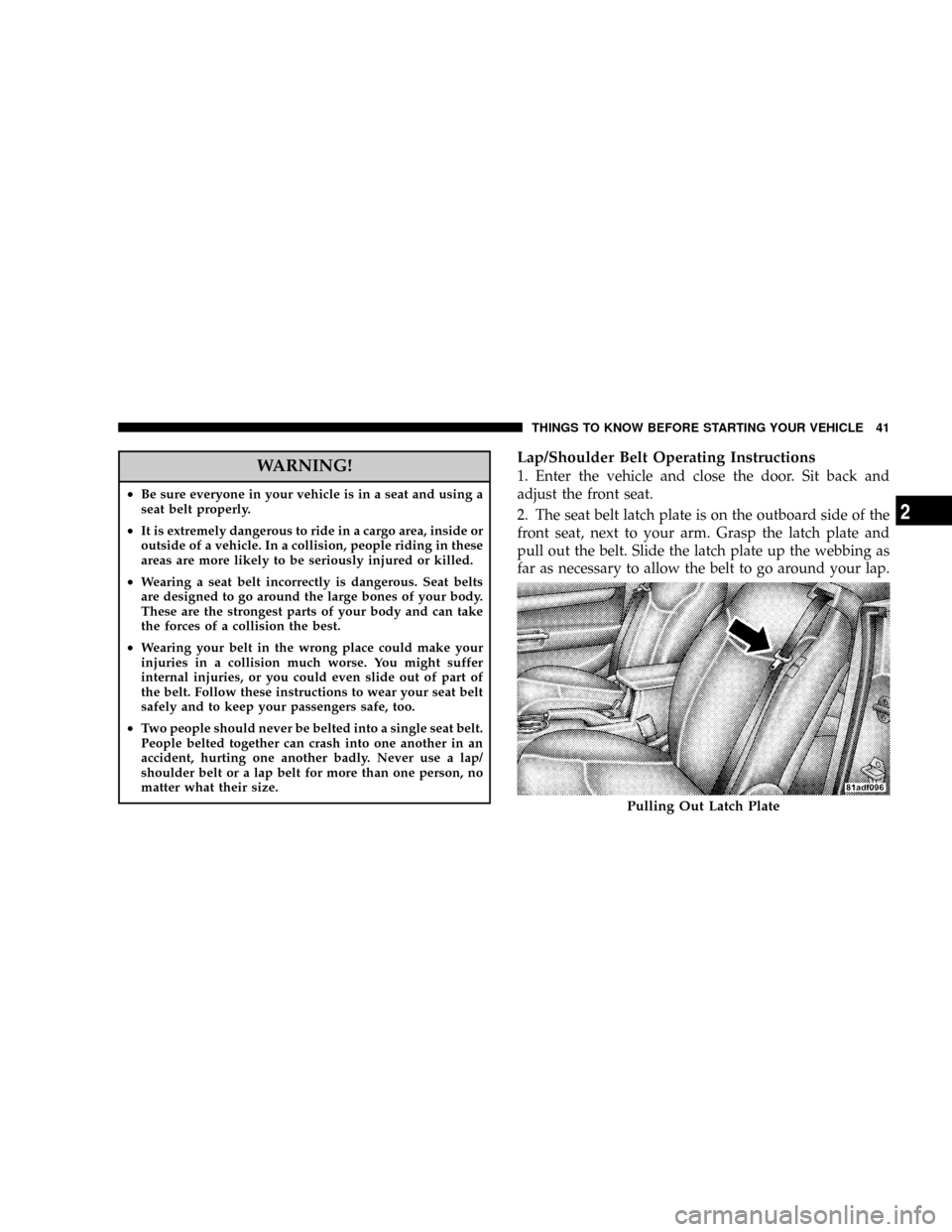CHRYSLER SEBRING CONVERTIBLE 2008 3.G Service Manual
Manufacturer: CHRYSLER, Model Year: 2008, Model line: SEBRING CONVERTIBLE, Model: CHRYSLER SEBRING CONVERTIBLE 2008 3.GPages: 454, PDF Size: 5.8 MB
Page 41 of 454

WARNING!
²Be sure everyone in your vehicle is in a seat and using a
seat belt properly.
²It is extremely dangerous to ride in a cargo area, inside or
outside of a vehicle. In a collision, people riding in these
areas are more likely to be seriously injured or killed.
²Wearing a seat belt incorrectly is dangerous. Seat belts
are designed to go around the large bones of your body.
These are the strongest parts of your body and can take
the forces of a collision the best.
²Wearing your belt in the wrong place could make your
injuries in a collision much worse. You might suffer
internal injuries, or you could even slide out of part of
the belt. Follow these instructions to wear your seat belt
safely and to keep your passengers safe, too.
²Two people should never be belted into a single seat belt.
People belted together can crash into one another in an
accident, hurting one another badly. Never use a lap/
shoulder belt or a lap belt for more than one person, no
matter what their size.
Lap/Shoulder Belt Operating Instructions
1. Enter the vehicle and close the door. Sit back and
adjust the front seat.
2. The seat belt latch plate is on the outboard side of the
front seat, next to your arm. Grasp the latch plate and
pull out the belt. Slide the latch plate up the webbing as
far as necessary to allow the belt to go around your lap.
Pulling Out Latch Plate
THINGS TO KNOW BEFORE STARTING YOUR VEHICLE 41
2
Page 42 of 454

3. When the belt is long enough to fit, insert the latch
plate into the buckle until you hear a ªclick.ºWARNING!
²A belt that is buckled into the wrong buckle will not
protect you properly. The lap portion could ride too high
on your body, possibly causing internal injuries. Always
buckle your belt into the buckle nearest you.
²A belt that is too loose will not protect you as well. In
a sudden stop, you could move too far forward, increas-
ing the possibility of injury. Wear your seat belt snugly.
²A belt that is worn under your arm is very dangerous.
Your body could strike the inside surfaces of the vehicle
in a collision, increasing head and neck injury. A belt
worn under the arm can cause internal injuries. Ribs
aren't as strong as shoulder bones. Wear the belt over
your shoulder so that your strongest bones will take the
force in a collision.
²A shoulder belt placed behind you will not protect
you from injury during a collision. You are more likely
to hit your head in a collision if you do not wear your
shoulder belt. The lap and shoulder belt are meant to be
used together.
Inserting Latch Plate Into Buckle
42 THINGS TO KNOW BEFORE STARTING YOUR VEHICLE
Page 43 of 454

4. Position the lap belt across your thighs, below your
abdomen. To remove slack in the lap belt portion, pull up
on the shoulder belt. To loosen the lap belt if it is too tight,
lift up on the shoulder belt and pull on the lap belt. A
snug belt reduces the risk of sliding under the belt in a
collision.WARNING!
²A lap belt worn too high can increase the risk of
internal injury in a collision. The belt forces won't be
at the strong hip and pelvic bones, but across your
abdomen. Always wear the lap belt as low as pos-
sible and keep it snug.
²A twisted belt can't do its job as well. In a collision,
it could even cut into you. Be sure the belt is straight.
If you can't straighten a belt in your vehicle, take it to
your dealer and have it fixed.
5. Position the shoulder belt on your chest so that it is
comfortable and not resting on your neck. The retractor
will withdraw any slack in the belt.
Positioning Lap Belt
THINGS TO KNOW BEFORE STARTING YOUR VEHICLE 43
2
Page 44 of 454

6. To release the belt, push the red button on the buckle.
The belt will automatically retract to its stowed position.
If necessary, slide the latch plate down the webbing to
allow the belt to retract fully.
WARNING!
A frayed or torn belt could rip apart in a collision and
leave you with no protection. Inspect the belt system
periodically, checking for cuts, frays, or loose parts.
Damaged parts must be replaced immediately. Do
not disassemble or modify the system. Seat belt
assemblies must be replaced after a collision if they
have been damaged (bent retractor, torn webbing,
etc.).
Lap/Shoulder Belt Untwisting Procedure
Use the following procedure to untwist a twisted lap/
shoulder belt.
1. Position the latch plate as close as possible to the
anchor point.
2. At about 6 to 12 inches (15 to 30 cm) above the latch
plate, grasp and twist the belt webbing 180É to create a
fold that begins immediately above the latch plate.
3. Slide the latch plate upward over the folded webbing.
The folded webbing must enter the slot at the top of the
latch plate.
4. Continue to slide the latch plate up until it clears the
folded webbing.
44 THINGS TO KNOW BEFORE STARTING YOUR VEHICLE
Page 45 of 454

Seat Belt Pretensioners
The seat belts for both front seating positions are
equipped with pretensioning devices that are designed to
remove slack from the seat belt in the event of a collision.
These devices improve the performance of the seat belt
by assuring that the belt is tight about the occupant early
in a collision. Pretensioners work for all size occupants,
including those in child restraints.
In addition, the front passenger seat belt includes a
two-stage load-limiting feature to enhance occupant pro-
tection for the same reason.
NOTE:These devices are not a substitute for proper seat
belt placement by the occupant. The seat belt still must be
worn snugly and positioned properly.
The pretensioners are triggered by the Occupant Re-
straint Controller (ORC) (refer to information on Airbags
in this section). Like the front airbags, the pretensionersare single use items. After a collision that is severe
enough to deploy the airbags and pretensioners, both
must be replaced.
Enhanced Seat Belt Reminder System (BeltAlertT)
If the driver's seat belt has not been buckled within 60
seconds of starting the vehicle and if the vehicle speed is
greater than 5 mph (8 km/h), the Enhanced Warning
System (BeltAlertt) will alert the driver to buckle their
seat belt. The driver should also instruct all other occu-
pants to buckle their seat belts. Once the warning is
triggered, the Enhanced Warning System (BeltAlertt)
will continue to chime and flash the Seat Belt Reminder
Light for 96 seconds or until the driver's seat belt is
buckled.
The Enhanced Warning System (BeltAlertt) will be reac-
tivated if the driver's seat belt is unbuckled for more than
10 seconds and the vehicle speed is greater than 5 mph (8
km/h).
THINGS TO KNOW BEFORE STARTING YOUR VEHICLE 45
2
Page 46 of 454

BeltAlerttProgramming
The Enhanced Warning System (BeltAlertt) can be en-
abled or disabled by your authorized dealer or by
performing the following steps:
NOTE:DaimlerChrysler does not recommend deacti-
vating the Enhanced Warning System (BeltAlertt).
1. With all doors closed, and the ignition switch in any
position except ON or START, buckle the driver's seat
belt.
2. Turn the ignition switch to the ON position, but do not
start the engine. Wait for the Seat Belt Reminder Light to
turn off and then proceed to the next step.
NOTE:You must perform the following steps within 60
seconds of turning the ignition switch to the ON position.3. Within 60 seconds of turning the ignition switch to the
ON position, unbuckle and then re-buckle the driver's
seat belt at least three times within 10 seconds, ending
with the seat belt buckled.
NOTE:Watch for the Seat Belt Reminder Light to turn
on while unbuckling and turn off while re-buckling the
seat belt. It may be necessary to retract the seat belt
partially after unbuckling it.
4. Turn the ignition switch to the LOCK position. A
single chime will sound to signify that you have success-
fully completed the programming.
The Enhanced Warning System (BeltAlertt) can be reac-
tivated by repeating this procedure.
NOTE:Although BeltAlerttis deactivated, the Seat Belt
Reminder Light will continue to illuminate as long as the
driver's seat belt is unbuckled.
46 THINGS TO KNOW BEFORE STARTING YOUR VEHICLE
Page 47 of 454

Automatic Locking Mode
In this mode, the shoulder belt is automatically pre-
locked. However, the belt will still retract to remove any
slack in the shoulder belt. The Automatic Locking Mode
is available on all passenger-seating positions. Use the
Automatic Locking Mode anytime a child safety seat is
installed in a passenger seating position. Children 12
years old and under should be properly restrained in the
rear seat whenever possible.
How To Engage The Automatic Locking Mode
1. Buckle the combination lap/shoulder belt.
2. Grasp the shoulder portion and pull downward until
the entire belt is extracted.
3. Allow the belt to retract. As the belt retracts, you will
hear a clicking sound. This indicates the safety belt is
now in the Automatic Locking Mode.
How To Disengage The Automatic Locking Mode
Unbuckle the combination lap/shoulder belt and allow it
to retract completely to disengage the Automatic Locking
Mode and activate the vehicle sensitive (emergency)
locking mode.
Seat Belts And Pregnant Women
We recommend that pregnant women use the seat belts
throughout their pregnancy. Keeping the mother safe is
the best way to keep the baby safe.
Pregnant women should wear the lap part of the belt
across the thighs and as snug across the hips as possible.
Keep the belt low so that it does not come across the
abdomen. That way the strong bones of the hips will take
the force if there is a collision.
THINGS TO KNOW BEFORE STARTING YOUR VEHICLE 47
2
Page 48 of 454

Seat Belt Extender
If a seat belt is too short, even when fully extended, your
dealer can provide you with a seat belt extender. This
extender should be used only if the existing belt is not
long enough. When it is not required, remove the ex-
tender, and stow it.
WARNING!
Using a seat belt extender when not needed can
increase the risk of injury in a collision. Only use
when the lap belt is not long enough when it is worn
low and snug, and in the recommended seating
positions. Remove and store the extender when not
needed.
Driver and Front Passenger Supplemental
Restraint System (SRS) - Airbag
This vehicle has airbags for both the driver and front
passenger as a supplement to the seat belt restraint
systems. The driver's front airbag is mounted in the
center of the steering wheel. The passenger's front airbag
is mounted in the instrument panel, above the glove
compartment. The words SRS AIRBAG are embossed on
the airbag covers.
48 THINGS TO KNOW BEFORE STARTING YOUR VEHICLE
Page 49 of 454

NOTE:The front airbags are certified to the Federal
regulations that allow less forceful deployment.
The front airbags have a dual-stage inflator design. This
may allow the airbag to have different rates of inflation
that are based on collision severity and occupant size.
WARNING!
²Do not put anything on or around the front airbag
covers or attempt to open them manually. You may
damage the airbags and you could be injured because
the airbags are no longer functional. These protective
covers for the airbag cushions are designed to open
only when the airbags are inflating.
²Do not use accessory seat covers or place objects
between you and the seat airbags; the performance
could be adversely affected and/or objects could be
pushed into you, causing serious injury.
²Do not attach cup holders or any other objects on or
around the door. The inflating seat airbag could drive
the object into occupants, causing serious injury.
²Do not drill, cut or tamper with the knee bolster in
any way.
²Do not mount any accessories to the knee bolster such
as alarm lights, stereos, citizens band radios etc.
Front Airbag Components
THINGS TO KNOW BEFORE STARTING YOUR VEHICLE 49
2
Page 50 of 454

Along with seat belts and pretensioners, front airbags
work with the knee bolsters to provide improved protec-
tion for the driver and front passenger. Seat airbags also
work with seat belts to improve occupant protection.
While the seat belts are designed to protect you in many
types of collisions, the front airbags will deploy in
moderate to severe frontal collisions. In certain types of
collisions, both the front and seat airbags may be trig-
gered. However, even in collisions where the airbags
work, you need the seat belts to keep you in the right
position for the airbags to protect you properly.
Here are some simple steps you can take to minimize the
risk of harm from a deploying airbag.
1.Children 12 years old and under should always ride
buckled up in a rear seat.Infants in rear facing child restraints shouldNEVERride
in the front seat of a vehicle with a passenger front airbag.
An airbag deployment can cause severe injury or death to
infants in that position.
Children that are not big enough to wear the vehicle seat
belt properly (Refer to information on Child Restraint in
this section) should be secured in the rear seat in child
restraints or belt-positioning booster seats. Older chil-
dren who do not use child restraints or belt-positioning
booster seats should ride properly buckled up in the rear
seat. Never allow children to slide the shoulder belt
behind them or under their arm.
If a child from 1 to 12 years old must ride in the front
passenger seat because the vehicle is crowded, move the
seat as far back as possible, and use the proper child
restraint. Refer to information on Child Restraint in this
section.
50 THINGS TO KNOW BEFORE STARTING YOUR VEHICLE